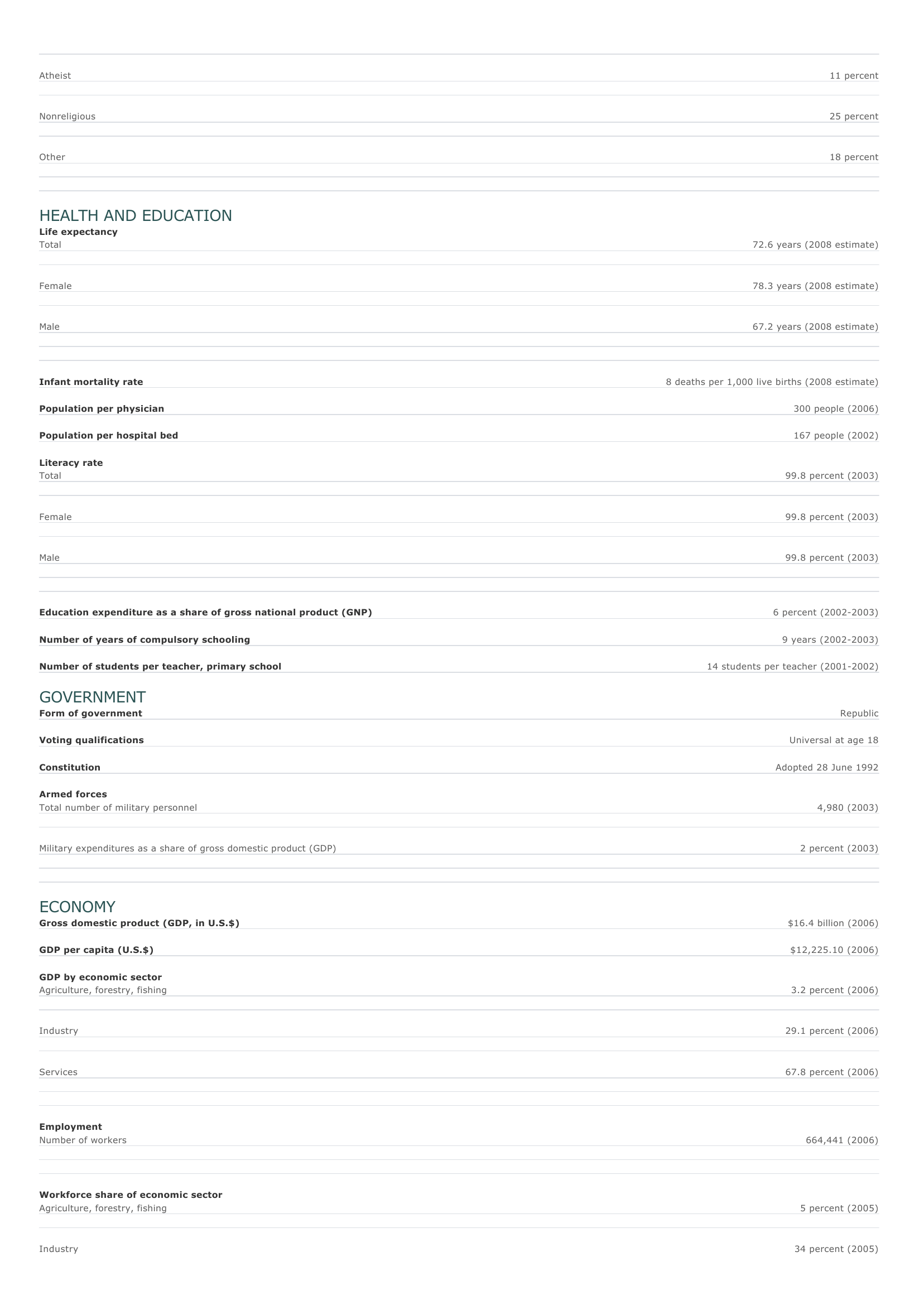Estonia Facts and Figures. BASIC FACTS Official name Capital Area Republic of Estonia Tallinn 45,227 sq km 17,462 sq mi PEOPLE Population 1,307,605 (2008 estimate) Population growth Population growth rate -0.63 percent (2008 estimate) Projected population in 2025 1,149,245 (2025 estimate) Projected population in 2050 861,913 (2050 estimate) Population density 30 persons per sq km (2008 estimate) 78 persons per sq mi (2008 estimate) Urban/rural distribution Share urban 70 percent (2005 estimate) Share rural 30 percent (2005 estimate) Largest cities, with population Tallinn 391,000 (2003 estimate) Tartu 101,190 (2003 estimate) Narva 67,752 (2003 estimate) Kohtla-Järve 46,765 (2003 estimate) P ärnu 44,781 (2003 estimate) Ethnic groups Estonian 64 percent Russian 29 percent Ukrainian 3 percent Belarusian 2 percent F inn 1 percent O ther 1 percent Languages Estonian (official), Russian, Ukranian, Belarusian, Finnish, Latvian, Lithuanain, German, English Religious affiliations Protestant 17 percent Orthodox Christian 16 percent Other Christian 13 percent Atheist 11 percent Nonreligious 25 percent O ther 18 percent HEALTH AND EDUCATION Life expectancy Total 72.6 years (2008 estimate) Female 78.3 years (2008 estimate) Male 67.2 years (2008 estimate) Infant mortality rate 8 deaths per 1,000 live births (2008 estimate) Population per physician 300 people (2006) Population per hospital bed 167 people (2002) Literacy rate Total 99.8 percent (2003) Female 99.8 percent (2003) Male 99.8 percent (2003) Education expenditure as a share of gross national product (GNP) Number of years of compulsory schooling Number of students per teacher, primary school 6 percent (2002-2003) 9 years (2002-2003) 14 students per teacher (2001-2002) GOVERNMENT Form of government Republic Voting qualifications Universal at age 18 Constitution Armed forces Total number of military personnel Military expenditures as a share of gross domestic product (GDP) Adopted 28 June 1992 4,980 (2003) 2 percent (2003) ECONOMY Gross domestic product (GDP, in U.S.$) $16.4 billion (2006) GDP per capita (U.S.$) $12,225.10 (2006) GDP by economic sector Agriculture, forestry, fishing 3.2 percent (2006) I ndustry 29.1 percent (2006) Services 67.8 percent (2006) Employment Number of workers Workforce share of economic sector Agriculture, forestry, fishing I ndustry 664,441 (2006) 5 percent (2005) 34 percent (2005) Services Unemployment rate 61 percent (2005) 9.6 percent (2004) National budget (U.S.$) Total revenue $5,216 million (2006) Total expenditure $4,359 million (2006) Monetary unit 1 Estonian kroon (EEK), consisting of 100 cents Major trade partners for exports Finland, Sweden, Russia, Latvia, and Germany Major trade partners for imports Finland, Russia, Germany, Sweden, and China ENERGY, COMMUNICATIONS, AND TRANSPORTATION Electricity production Electricity from thermal sources Electricity from hydroelectric sources Electricity from nuclear sources Electricity from geothermal, solar, and wind sources Number of radios per 1,000 people 99.59 percent (2003 estimate) 0.07 percent (2003 estimate) 0 percent (2003 estimate) 0.34 percent (2003 estimate) 1,073 (2000 estimate) Number of telephones per 1,000 people 328 (2005) Number of televisions per 1,000 people 608 (2000 estimate) Number of Internet hosts per 10,000 people 499 (2003) Daily newspaper circulation per 1,000 people 173 (1996) Number of motor vehicles per 1,000 people 459 (2004) Paved road as a share of total roads 24 percent (2004) SOURCES Basic Facts and People sections Area data are from the statistical bureaus of individual countries. Population, population growth rate, and population projections are from the United States Census Bureau, International Programs Center, International Data Base (IDB) (www.census.gov). Urban and rural population data are from the Food and Agriculture Organization (FAO) of the United Nations (UN), FAOSTAT database (www.fao.org). Largest cities population data and political divisions data are from the statistical bureaus of individual countries. Ethnic divisions and religion data are largely from the latest Central Intelligence Agency (CIA) World Factbook and from various country censuses and reports. Language data are largely from the Ethnologue, Languages of the World, Summer Institute of Linguistics International (www.sil.org). Health and Education section Life expectancy and infant mortality data are from the United States Census Bureau, International Programs Center, International database (IDB) (www.census.gov). Population per physician and population per hospital bed data are from the World Health Organization (WHO) (www.who.int). Education data are from the United Nations Educational, Scientific and Cultural Organization (UNESCO) database (www.unesco.org). Government section Government, independence, legislature, constitution, highest court, and voting qualifications data are largely from various government Web sites, the latest Europa World Yearbook, and the latest Central Intelligence Agency (CIA) World Factbook. The armed forces data is from Military Balance. Economy section Gross domestic product (GDP), GDP per capita, GDP by economic sectors, employment, and national budget data are from the World Bank database (www.worldbank.org). Monetary unit, agriculture, mining, manufacturing, exports, imports, and major trade partner information is from the statistical bureaus of individual countries, latest Europa World Yearbook, and various United Nations and International Monetary Fund (IMF) publications. Energy, Communication, and Transportation section Electricity information is from the Energy Information Administration (EIA) database (www.eia.doe.gov). Radio, telephone, television, and newspaper information is from the United Nations Educational, Scientific and Cultural Organization (UNESCO) database (www.unesco.org). Internet hosts, motor vehicles, and road data are from the World Bank database (www.worldbank.org). Note Figures may not total 100 percent due to rounding. Microsoft ® Encarta ® 2009. © 1993-2008 Microsoft Corporation. All rights reserved.










